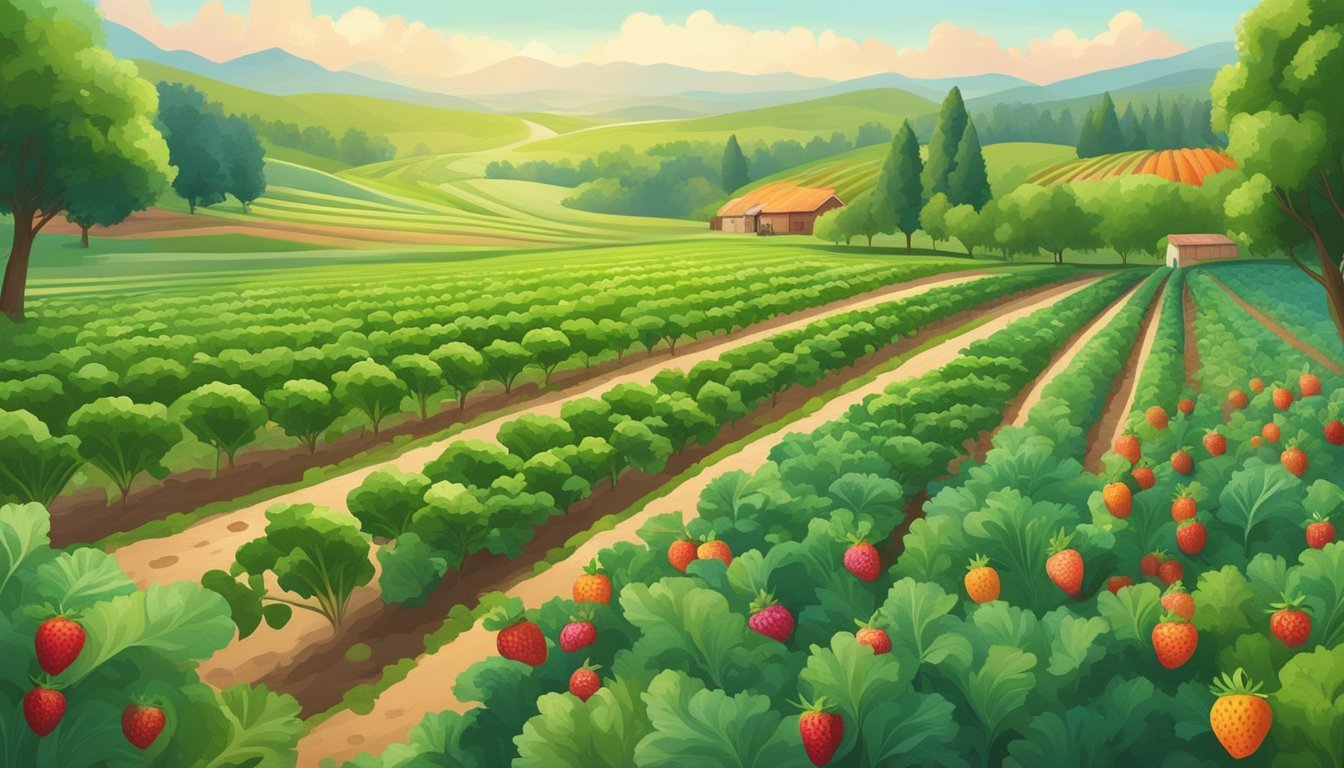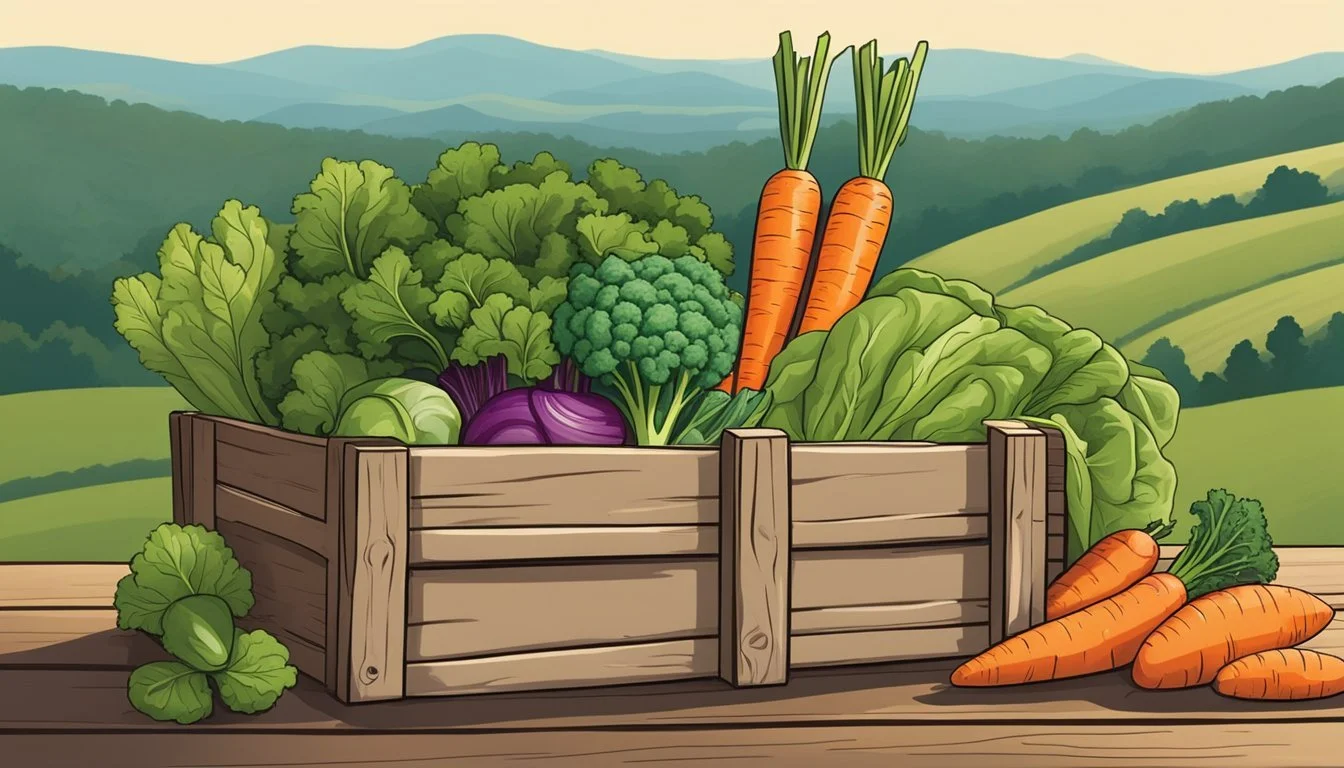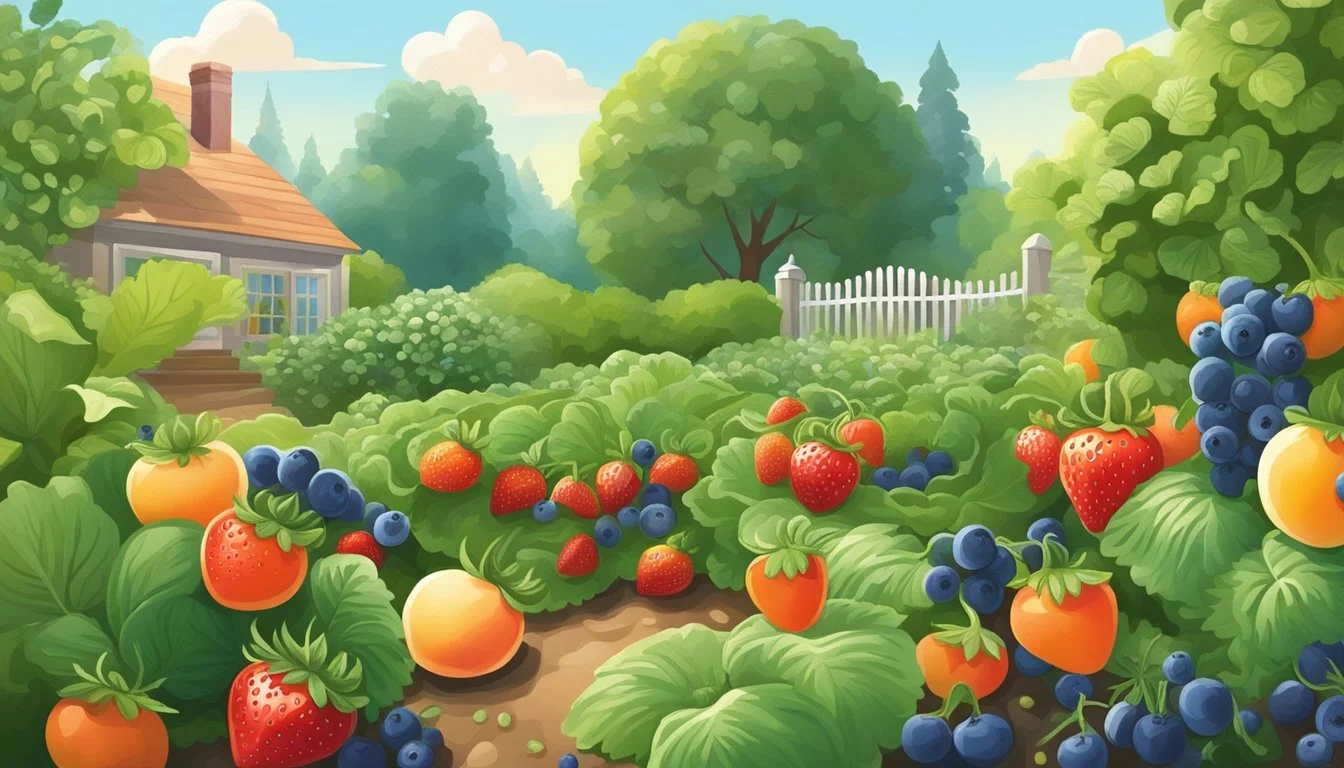Arkansas Seasonal Fruit & Vegetables in March
Your Guide to Fresh Produce
This Article is Part of our Arkansas Seasonal Fruit & Veg Calendar
March in Arkansas heralds a period of transition, where the tail end of winter's cold gives way to the gentle unfolding of spring. This seasonal shift is particularly significant in the world of agriculture, as it marks a time when certain fruits and vegetables reach their optimal freshness. In Arkansas, the focus is on robust, cold-hardy produce that can withstand the cool temperatures that often linger in the early days of the month.
Within the state's varied climate, gardeners and farmers are busy harvesting the last of the winter crops and beginning to plant for the spring. Leafy greens such as kale, spinach (What wine goes well with spinach?), and collard greens (how long do collard greens last?) are still available in abundance, having thrived in the cooler temperatures. These nutritious greens are joined by root vegetables like turnips and radishes, which are typically resilient to the frost and offer a fresh, earthy flavor to dishes.
March is a crucial time for Arkansans to support local farmers by choosing seasonal produce. Not only does this ensure the consumption of fruits and vegetables at their peak freshness, but it also contributes to the sustainability of the local agricultural economy. As the month progresses, the variety and volume of in-season produce will increase, providing even more opportunities for fresh and flavorful meals.
Seasonal Fruits Overview
In Arkansas, March heralds the transition period for seasonal fruits, with winter varieties phasing out and early spring fruits making their entrance. This month, one can expect to see the last of the citrus fruits, while berries are not yet in peak season.
Citrus Fruits
During March in Arkansas, citrus fruits are often at the tail end of their season. Shoppers can find:
Oranges: Often still sweet and juicy, perfect for a burst of Vitamin C.
Grapefruits: Known for their slightly bitter, yet refreshing taste.
Berries
While March is slightly early for the local berry season in Arkansas, some imported varieties might be available in markets:
Strawberries: Sometimes available, but not at their peak.
Blueberries: They are more commonly in season later, so offerings in March might be limited.
Melons
March does not typically mark the season for melons in Arkansas. Locally-grown:
Watermelon: Expected in warmer months.
Cantaloupe (how long does cantaloupe last?): Anticipated later in the year when the climate is suitable for their growth.
Consumers may find some imported melons, but peak freshness aligns with their respective growing seasons later in the year.
Seasonal Vegetables Guide
March in Arkansas heralds the arrival of spring and with it a diverse variety of vegetables that thrive in the transitional weather. Gardeners and consumers alike can look forward to planting and enjoying a range of leafy greens, hearty root vegetables, and other spring favorites.
Leafy Greens
In Arkansas, March is an excellent time for leafy greens, which flourish in the cool, mild temperatures. Gardeners should consider planting lettuce and spinach, which are quick to harvest and highly versatile in the kitchen. Kale, with its nutrient-rich leaves, is also a strong choice for early spring gardens and can often withstand variable weather conditions.
Lettuce: Varieties include 'Romaine' and 'Leaf'
Spinach: Suitable for salads and cooking
Kale: 'Curly', 'Dinosaur', and 'Red Russian' are popular types
Root Vegetables
As the soil begins to warm, root vegetables become a viable option. They are generally robust and can be planted early. Radishes are particularly well-suited to March planting, offering a fast-growing crop that can be ready to harvest in as little as a month. Those hoping for later-season crops might also start turnips and parsnips, which take longer to mature but are excellent for extended harvesting.
Radishes: Quick maturing; space seeds for optimal growth
Turnips: Require more growth time; serve well mashed or roasted
Parsnips: Need a full season to develop; sweeten after a frost
Spring Vegetables
Cabbage is a hallmark spring vegetable in Arkansas and can be started this month for a later spring harvest. It is important to space out the planting of cabbage to avoid overcrowding and to ensure a successful crop. These spring vegetables can provide a bountiful harvest, perfect for both fresh salads and cooked dishes.
Cabbage: Space adequately for head development; versatile in recipes
Selecting and Storing Tips
In March, Arkansas's seasonal produce offers vibrant flavors and freshness if selected and stored correctly. These guidelines ensure one enjoys the best taste and longevity from their fruits and vegetables.
Fruit Selection
When selecting fruits, one should look for firmness and rich colors, indicative of peak ripeness and flavor. Fruits should not have soft spots or bruises. Here are specific tips for common March fruits in Arkansas:
Apples: Choose ones that are firm to the touch and have a consistent color without any significant blemishes.
Strawberries: Seek bright red berries with a strong, sweet aroma and no signs of mushiness or mold.
Vegetable Storage
Proper storage is crucial for maintaining the freshness of vegetables. Different vegetables require different storage environments:
Leafy Greens: Refrigerate in a plastic bag or airtight container. They generally stay fresh for about a week.
Root Vegetables: Store in a cool, dark place with good ventilation for optimal longevity.
Shelf Life Optimization
Maximizing shelf life means keeping produce in conditions that slow deterioration. Here’s how to extend the life of fruits and vegetables:
Produce Type Method of Storage Expected Shelf Life Apples Fridge, crisper drawer 4-6 weeks Strawberries Fridge, in original container or a paper towel-lined airtight container 3-7 days Leafy Greens Fridge, plastic bag with air expelled Up to 1 week Root Vegetables Cool, dark place Several weeks to 2 months
Adhering to these specific selection and storage methods ensures one enjoys the seasonal produce at its best flavor and freshness.
Culinary Uses and Recipes
In Arkansas during March, a bounty of fresh produce provides an abundance of options for culinary exploration. Chefs and home cooks alike can transform these seasonal offerings into vibrant salads, flavorful roasted dishes (What wine goes well with roasted dishes?), and an array of recipes that deliver the freshness of spring to the table.
Salad Inspirations
Seasonal greens such as spinach, Swiss chard, and arugula (how long does arugula last?) offer the foundation for nutritious and colorful salads. A simple Spring Green Salad could feature:
Spinach
Arugula
Sliced radishes
Chopped hard-boiled eggs
A homemade Creamy Herb Dressing with fresh dill and a touch of lemon.
Tip: Pair leafy salads with slivers of in-season vegetables like radishes to add a peppery crunch.
Cooking Techniques
March is an ideal time to explore cooking techniques like roasting that can intensify the natural flavors of Arkansas produce. Roasted Asparagus (how long does asparagus last?)is simple to prepare:
Toss asparagus spears with olive oil, salt, and pepper.
Roast in a preheated oven at 400°F (200°C) for around 20 minutes until tender.
Roasting can also be applied to other vegetables like broccoli (how long does broccoli last?)or root vegetables such as rutabaga for a caramelized finish.
Recipe Ideas
The fresh ingredients available in March can be used to create a variety of recipes. Here are two ideas that feature seasonal produce:
Creamy Roasted Broccoli Pasta (how long does pasta last?):
Roast broccoli until browned.
Toss with cooked pasta and a creamy garlic sauce.
Rutabaga and Carrot Salad:
Shred rutabaga and carrots.
Mix with a light vinaigrette dressing and fresh herbs.
Utilize Arkansas's March produce to enhance meals with freshness and flavor. Whether in salads with vibrant dressings or as part of a main dish where they're roasted to perfection, the ingredients offer endless possibilities for delicious recipes.
Health Benefits and Nutrients
Consuming seasonal fruits and vegetables from Arkansas in March ensures that individuals receive the freshest produce, packed with optimal nutrition. This contributes significantly to their overall health by providing a rich array of vitamins, dietary fiber, and antioxidants, essential to maintaining a well-balanced diet.
Vitamin Content
Seasonal produce such as spinach and kale are excellent sources of vitamins A, C, and K, key components for maintaining good vision, skin health, and blood clotting processes. Additionally, citrus fruits that are in season may contribute a significant amount of vitamin C, vital for immune system function and iron absorption.
Dietary Fiber
Vegetables like artichokes (What wine goes well with artichokes?) and fruits such as pears, which are typically harvested in March, possess high levels of dietary fiber. Including these in the diet aids digestive health by helping to maintain regular bowel movements and may also contribute to lowering cholesterol levels.
Antioxidants
Seasonal fruits including berries, when available, offer a strong antioxidant profile, thanks to compounds like vitamin C, vitamin E, and beta-carotene. These antioxidants protect the body's cells from damage, which is instrumental in preventing chronic diseases and promoting overall health. Organic varieties of these items might have lower pesticide residues, which is an additional benefit to consider for those choosing organic produce for health reasons.
Growing Your Own Produce
In Arkansas, March marks a transitional period for gardeners, offering a unique opportunity to start growing a variety of fruits and vegetables. The key to success lies in understanding the seasonal climate, selecting the right type of produce, and knowing when to begin the harvesting process.
Home Gardening Tips
For those starting a vegetable garden in March, it's crucial to consider the sunlight exposure and soil conditions. Most vegetables require a sunny location, with a minimum of six hours of direct sunlight per day. Preparing the soil with organic matter can enhance its fertility, structure, and moisture retention, providing an ideal base for the plants to thrive. One must also be mindful of spacing, as overcrowded plants can lead to poor air circulation and higher susceptibility to diseases.
Seasonal Gardening
When selecting seasonal produce, gardeners should focus on vegetables that can tolerate the cool temperatures of early spring in Arkansas. For instance, planting lettuce is a wise choice, as it can grow even in the presence of light frost. Here's a list of vegetables and their optimal planting times in March:
Lettuce: Cold-hardy varieties such as Butterhead and Loose Leaf.
Kale: Known for its resilience in cooler temperatures.
Spinach: Prefers the chill of early spring.
Planting schedules can vary within different climate zones in Arkansas, so it's important to adjust timing accordingly.
Harvesting Your Garden
As the season progresses, monitoring the growth of the garden is vital. Leafy greens like lettuce and spinach can be harvested as soon as they've reached a suitable size. However, patience is key, as harvesting too early can reduce yield, while too late can affect taste and texture. Keeping a record of planting dates and expected maturity can assist gardeners in determining the optimal harvesting time, ensuring the fruits of their labor are enjoyed at peak freshness.
Local Market Guide
March in Arkansas signals the transition to spring, which brings a variety of fresh produce to local markets. This is an opportune time to explore farmers' markets in the state, understand the seasonality of produce, and engage in supporting the local agricultural community.
Finding Farmer's Markets
Farmers' markets are bustling hubs where one can find fresh, in-season produce directly from the growers. In Arkansas, markets can be located through the state's Department of Agriculture or resources like LocalHarvest. Many markets also often feature on Pinterest, providing updates on available produce and market events.
Understanding Seasonality
Grasping the concept of seasonality ensures consumers purchase the freshest produce at its peak. March offerings typically include spinach, kale, lettuce, and the last of the winter squash. A seasonal produce calendar is a valuable resource for shoppers and can often be found through local agriculture extensions.
Supporting Local Agriculture
Supporting local markets has a significant impact on the state's economy and environment. When consumers buy locally, they help sustain Arkansas farmers and reduce the carbon footprint associated with transporting goods. Local support also fosters community and economic growth, making it a win-win situation for both the consumer and the producer.








